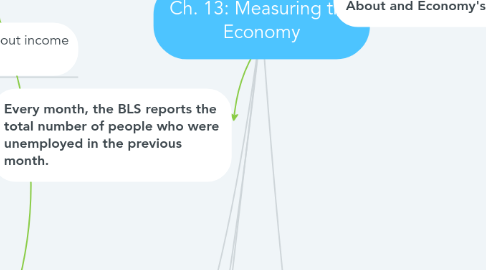Ch. 13: Measuring the Economy
by Mike Graalum

1. 13.2: How Do Economists Measure the Size of the Economy?
2. 13.4: What Does the Inflation Rate Reveal About an Economy's Health?
3. Key Terms
4. Gross Domestic Product (GDP): The final market value of all final goods and services produced within a country during a given period of time.
5. Economists can calculate the GDP by taking: Household Consumption+Business Investment+Government Purchases+Net Exports and get the GDP (C+I_G_Nx=GDP)
6. Economists use GDP to determine how big the economy is and whether it is growing or shrinking and at what rate.
7. There are many limitations to the GDP
8. GDP leaves out unpaid household and volunteer work
9. GDP ignores informal and illegal exchanges
10. GDP counts some negatives as positives
11. GDP ignores negative externalities
12. GDP places no value on leisure time
13. GDP says nothing about income distribution
14. Countries with a higher GDP tent to have a higher literacy and education rate, health and life expectancy, and standard of living.
15. Every month, the BLS reports the total number of people who were unemployed in the previous month.
16. BLS tracks inflation by gathering information on Americans' cost of living.
17. The real cost of living can be used to compare prices overtime.
18. As prices go up, wages will generally go up also.
19. Economic Costs of Inflation
20. Loss of purchasing power
21. High interest rates.
22. Loss of economic efficiency
23. Economists keep a close eye on inflation.
24. Unemployment rate: the percentage of the labor force that is not employed but is actively seeking work
25. Underground economy: a sector of the economy based on illegal activities, such as drug dealing and unlawful gambling
26. Market value: the price buyers are willing to pay for a good or service in a competitive market
27. 13.5: How Does the Business Cycle Relate to Economic
28. 13.3: What Does the Unemployment Rate Tell Us About and Economy's Health?
29. When the economy has full employment, everybody who wants to work is working.
30. There are four different types of unemployment.
31. The main economic cost of high unemployment is lost potential output.
32. Unemployment rate is a useful indicator of the health of an economy.
33. Four Phases of the Business Cycle
34. Expansion
35. Expansion ends and there is a peak.
36. Contraction
37. Contraction ends and there is a trough
38. Business cycles are hard to predict.
39. Business cycles are known as boom and bust,
40. Business cycles are very irregular.
41. Business Cycle: a recurring pattern of growth and decline in economic activity over time
42. Recession: a period of declining national economic activity, usually measured as a decrease in GDP for at least two consecutive quarters
43. Inventory: merchandise that companies or stores have on hand
44. Nominal wages: wage levels based on current dollars
45. Real wages: wage levels based on constant dollars.


